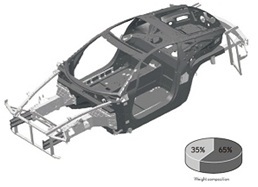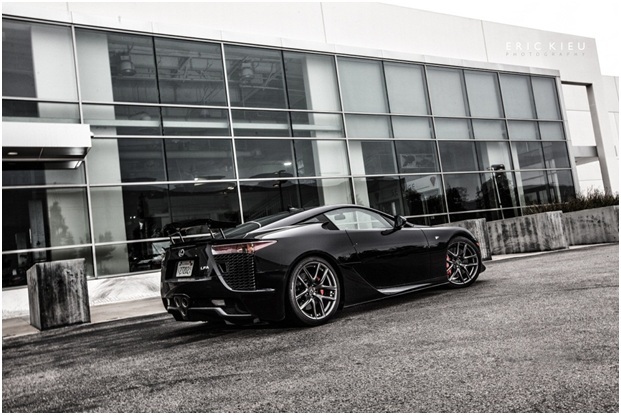Lexus LFA
There is no doubt the Toyota 2000GT was a message from the
Japanese automobile manufacturer that
they could build sports car to rival those of Europe. The car was viewed
by most as a high performance GT with luxurious interior. It was used in
multiple races in Japan and also broke several speed and endurance records,
showing how Toyota was
able to build high performance sports car with rock solid reliability.
Only 351 2000GT was built between 1967 and 1970 making it a highly
collectable now.
Almost 3 decades later, Toyota decided to enter the Formula
One racing in 1999. Similar to Honda, Toyota decided not to partner with
other racing teams or chassis manufacturers, instead developing their own works
team from ground up. Although they did not win a Grand Prix before
withdrawing from the sport in 2009, they took this opportunity to advance in
sports car development. It was exactly during this time that the LFA
project received the green light in early 2000.
As Toyota's premium brand, for the longest time Lexus
vehicles have been labeled as luxurious vehicles without souls, and this has
hurt Lexus demographics over the years as the average age of owners grew older.
To change that, Lexus has to make their cars more exciting and appealing
to younger buyers - the LFA was the start.
The LFA was a project with no budget in mind and took
10 years to finish. When engineers discovered that the aluminum body was
too heavy, years into the design, management threw in another pile of cash to
explore carbon fiber technology. They developed their own proprietary
carbon fiber looming machines and a stronger aluminum flanged collar. In
the end, 65% of the structure is composed of Carbon Fiber Reinforced Plastic
(CFRP), which is 200 lbs. lighter over an aluminum equivalent design.

nlike the NSX, driving the LFA is a "fancy"
experience. Get into the cockpit and there are few steps before you can
fire up the engine. You run into an uncommon seat belt setup because of
the integrated airbags. After that you scramble for the mystery button to
put the car in reverse, followed by the sequence to put it into the forward
gear.
But really, one can totally look past all that when the
start button is pressed and the sleeping V10 awakes with that angry roar.
Lexus wanted to make the LFA sound like a F1 and Yamaha truly delivered.
Not only did they design a special acoustically tuned intake surge tank
and titanium exhaust, they even created several chambers to feed the incredible
engine sound into the cabin. At high RPMs it has that get-into-your-bone
pitch, which still gives me goose bumps every time.
The LFA is powerful and fast, but you get used to tossing it
around at high speed fast. Big part of this is due to the fantastic
chassis design and drive configuration, but the Sport Vehicle Dynamics
Integrated Management (VDIM) system also comes into play. This sophisticated
system monitors various sensors and control systems including ABS, TRAC, and
VSC to analyze the driving conditions and vehicle status. Through its
predictive logics and algorithms, it coordinates and actively corrects under-
and over-steer, wheelspins, and stability. Lexus adjusted the system
specifically for the LFA to give driver more freedom and confidence in pushing
the vehicle. Instead of "saving" the car when it reaches the
dynamic limits like most traction control systems do, the LFA Sports VDIM
system actively predicts what's ahead and starts correcting right before the
limits.

The LFA has some ridiculously good Carbon Ceramic Material
Brembo brakes. In fact, they are so powerful (yet linear) that I worry
about cars behind not being able to stop fast enough. Hard braking at
high speeds gives the feeling like my eyeballs are being pulled out of their
sockets. I absolutely love it.
The LFA also features an electric power steering rack, but
the gear ratio is substantially better than the NSX at 14.3:1 and it takes 2.35
to turn lock-to-lock. So it does not matter if I am driving on local
streets or highways, I never have to take my hands off the 3 and 9 o'clock
positions of the steering wheel.

Transmission is probably what I feel most confused about.
People argue forever if the LFA should have a DCT instead but I think
it's just a matter of choice. Having good driving feedback is important
and the LFA definitely delivers that. Putting the car in Sport Mode and
fastest shifting speed, and you want to make sure you don't cough up leftover
lunch when flipping the shift pedal at redline. But comparing to other
supercars the LFA does shift relatively "slow" at 200ms. Is it
a big deal? No. But given how much attention Lexus has put in the
LFA, I think there is room for improvement.

Good thing with the transmission though is adjustability,
allowing normal driving to be more pleasant with smoother shifting.
Throttles are also adjusted in different modes to aid driving
characteristics on public roads, which I think is crucial in making the LFA
such an easy car to drive. It also has cylinder deactivation in Normal Drive
mode.
The Black LFA I drove has 23,000 miles and the Yellow
pre-production LFA has over 27,000 miles, mostly on the track or through demo,
which means they are very hard driven miles. When talking to the
technician who is responsible for the maintenance, these cars only receive
regular oil and brake pad changes (due to track use). That says a lot
about reliability.
Source: http://www.clublexus.com/articles/news/lexus-lfa-acura-nsx-two-decades-of-engineering-excellence.php
By Henry Kuo
photos by Eric Kieu
photos by Eric Kieu
http://www.boscheuropean.com
No comments:
Post a Comment